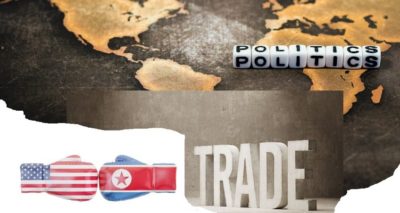By Bob Brewer, VP of Marketing, BLG
Politics and trade, it’s a study in “Politrade”, especially in a few choice countries in Asia. For the first time since taking the official seat of power in the DPRK six years ago Kim Jung Un is stepping outside the boundaries, literally of course, as he prepares to meet with S. Korean leaders on April 27th, having just left a meeting with Xi Jinping in Beijing, and someday soon, a proposed meeting with the POTUS. Kim Jong Un, and the POTUS face-to-face, imagine that. I don’t think this particular meeting would take place at the new White House, (Mar-A-Lago), and certainly not the little blue buildings in the demilitarized zone between North and South Korea, as that’s just not anywhere near fancy enough for our administration. Maybe they could meet on a multi-million dollar yacht built by China’s ship builder Wong, at the Hong Kong Yacht Club, (for the sake of neutrality) since China is key to anything progressing in a positive manner.
In recent years, despite Beijing’s displeasure at Kim Jong-un’s relentless pursuit of becoming a nuclear DPRK, the relationship between China and North Korea remains fairly solid from a trade perspective. China still provides North Korea with most of its food and energy supply and accounts for more than 90 percent of North Korea’s total trade volume. Despite announced trade restrictions in textiles, seafood, and oil products, there are reports of several North Korean businesses still in operation in China, beyond the simple karaoke bars with a direct line to Kim’s personal account. The fact remains, even in the face of mounting pressure by Washington to enforce the tough sanctions, China must remain in support of Kim Jong-un’s regime, as its worst nightmare is a total regime collapse and a refugee flood of migrants across their 870-mile border. As unstable as North Korean leadership has been under Kim Jong Un, China’s policies in dealing with him like a “son” have done little to deter his nuclear ambitions, which has of course strained its relations with the Trump administration. As Trump once said, “If China is not going to resolve the N.Korea problem, then we will.”
China’s “Kim friendly gloves” have been the cause for much consternation between the U.S. and China recently, and the jury is still out on how they are handling Kim’s nuclear developments. Oh to have been a fly on the wall at the recent meeting in Beijing with Xi Jinping and Kim Jong Un. To their credit, China did back UN Resolution 2375 in September 2017 after some of the measures in a draft version were dropped, including an oil embargo and the authorization to use force when ships do not comply with mandated inspections. Use of force is not on the table with Beijing, as Washington officials doubt China’s commitment to implementing even the most limited trade restrictions. So, in order to show the world, and Washington, some parental force with Kim, China’s commerce ministry did temporarily suspend coal imports from North Korea in February 2017, and subsequently there was a 16.7% drop in Chinese imports from North Korea in first three quarters of 2017. That hurt, and got Kim’s attention, and also got him on a long train ride to Beijing.
So how is the coal trade still flowing? A few years ago the two countries opened a bulk-cargo and container shipping route to boost North Korea’s export of coal to China and China established a high-speed rail route between the Chinese border city of Dandong and Shenyang. Dandong is a hub for trade, as 70 percent of annual trade in and out of North Korea is conducted via Dandong. North Korea’s dependence on China continues to grow, and coal export is key to survival.
It’s also worth noting that a true showing of how much Beijing favors a stable relationship with Pyongyang, is displayed via its ties with Seoul. China’s Xi Jinping has met with South Korean President Moon Jae-in and his predecessor, Park Geun-hye, on several occasions. China was South Korea’s top trading partner in 2017 and the destination for a quarter of the South’s exports. Meanwhile, South Korea ranked fourth among China’s trade partners, even with THAAD in the picture. Speaking briefly of the military aspect of negotiations to come, some experts say China has been ambivalent about its commitment to defend North Korea in case of military conflict. The United States appears more interested in leveraging China’s economic influence over North Korea rather than butting heads directly with Kim, as that will resolve nothing, just like the flinging of insults about a month ago. Other experts, argue that Washington should impose more secondary sanctions that will penalize Chinese banks that help finance North Korean front companies. The U.S. Treasury has done just that, imposing some secondary sanctions on both Chinese and Russian entities. Meanwhile, other analysts worry that such economic pressures and further alienation of Pyongyang could cause the Kim regime to resort to rash military action.
In conflicting reports, North Korea has vowed that the country’s nuclear weapons program will never be up for negotiation, but if I read some reports correctly, Kim supposedly has recently said that it’s a possibility. It will be interesting to see what develops in the next month with the upcoming meetings, and at the same time, I think it’s fair to look at what’s happening (Kim coming out for a stroll) and to say, the Chinese have done their part with implementing the trade sanctions, or this would never have happened.























